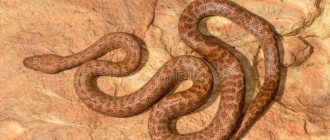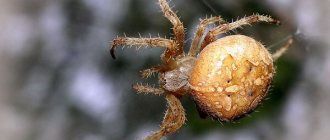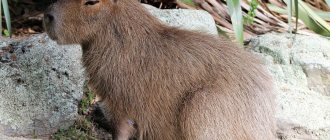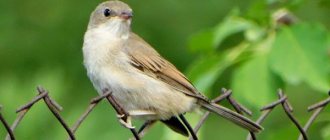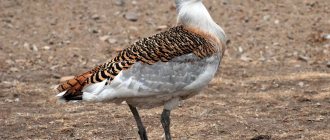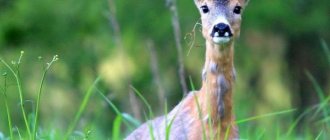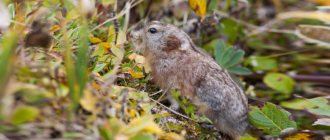A hedgehog is an animal that belongs to the phylum Chordata, class Mammals, order Urchiniformes, family Urchinaceae (Erinaceidae).
The origin of the Russian word “hedgehog” has not yet been fully studied. According to one version, the hedgehog got its name from the Greek “echinos”, which means “snake eater”. Supporters of another version see in the word “hedgehog” the Indo-European root “eg`h”, meaning “to prick”.
Hedgehog: description and photo. What does the animal look like?
The body length of a hedgehog, depending on the species, ranges from 10 to 44 cm. The weight of a hedgehog varies from 300 grams to 1.5 kilograms. The animal also has a tail, which grows from 1 to 21 cm in length.
Hedgehog tail
The animals have a large wedge-shaped head and an elongated muzzle with a pointed, mobile and moist nose.
The hedgehog's teeth are small and sharp; there are 20 teeth on the upper jaw and 16 on the lower jaw. Some types of hedgehogs have up to 44 teeth. The first incisors are enlarged and look like fangs.
The hind legs are longer than the front legs, each limb ends in 5 fingers, with the exception of the white-bellied hedgehog, whose hind legs have 4 fingers.
Long middle fingers help the hedgehog clean its spines.
The hedgehog's spines are hollow, with thin, sparse, barely noticeable hairs growing between them. The head and belly of the animal are covered with regular fur. On average, each hedgehog carries up to 10 thousand needles, which are gradually renewed.
The color of the needles of most species is dark, with alternating light stripes. The color of a hedgehog's fur, depending on the species, can be black-brown, brown, sand or white. In some places, the black color displaces the white, forming peculiar spots.
Most species of hedgehogs are distinguished by well-developed subcutaneous muscles. When in danger, the hedgehog curls up into a ball, and in this it is helped by the subcutaneous muscles located in the places where the spines grow.
Like most nocturnal animals, hedgehogs have poor vision, but their hearing and sense of smell are well developed.
It is difficult to call these animals fast; the average speed of a fleeing hedgehog is 3-4 km/h. Despite the fact that the hedgehog is a land animal, most species are excellent swimmers and climbers.
The main thing is needles!
The average number of needles on each hedgehog is up to 10,000, and their constant growth and renewal occurs. They are mostly dark in color, sometimes alternating with stripes of a lighter shade.
Depending on the species, a hedgehog can be brown, black, brown, sandy or even white in color. In some places, white and black colors alternate with the formation of spots. Most hedgehogs have well-developed subcutaneous muscles. A characteristic feature of these animals is to curl up into a ball when encountering danger. It is for this purpose that developed subcutaneous muscles are needed, which are located along the line of spine growth.
The hedgehog is a nocturnal animal with poor vision. As compensation, nature endowed him with excellent sense of smell and hearing. This animal cannot be called agile. The hedgehog usually runs away at an average speed of no more than 3-4 km per hour. The hedgehog is a land animal, but most of its species can swim well.
The natural lifespan of a hedgehog is about 3-5 years. If you place a hedgehog in a home environment, then in the absence of natural enemies it can live up to 8-10 years. In nature, its life is shorter. In the forest where the hedgehog lives, he becomes the object of hunting by foxes, wolves, owls, badgers, ferrets, mongooses, jackals, hyenas, eagles and many other predators. And even in the conditions of, for example, a city park, his life is full of dangers.
Hedgehog lifespan
The lifespan of a hedgehog in nature is 3-5 years. At home, hedgehogs live up to 8-10 years, as they do not die from natural enemies that hunt hedgehogs in the wild. The main enemies of hedgehogs are wolves, foxes, ferrets, owls, badgers, martens, mongooses, hyenas, jackals, honey badgers, eagles, and other predators.
What do they eat
The hedgehog's diet is very varied. Most of the food consists of various insects and their larvae. Adults often feed on snails, frogs, small reptiles and rodents.
Forest hedgehogs eat berries, mushrooms, fruits of trees and shrubs. Contrary to popular belief, they do not deliberately hunt snakes.
From mid-summer, the animal becomes incredibly voracious and can eat in a day an amount of food whose weight is equal to a third of its own body weight.
Where do hedgehogs live?
The habitat of hedgehogs is quite wide: this prickly animal is found in all European countries - from the southern regions of Scandinavia to the British Isles; the hedgehog lives in Russia and hot Africa, in Asia, New Zealand and the Middle East.
In nature, wild hedgehogs live in forests, deserts, steppes, cultivated landscapes and even cities. They dig burrows under tree roots or in bushes, and also settle in abandoned rodent burrows.
Habitat
Representatives of the hedgehog family settled in completely different places. Their habitat is wide, but not ubiquitous. They live in dry and wet forests, near bodies of water and far from them, in clearings and forest edges, in the steppes, in the sands of deserts, at a two-kilometer altitude in the mountains and even in forest belts and parks. They can live close to human dwellings and populated areas. The only things they don't like are very swampy areas and dense coniferous forests.
Hedgehogs, real and rat, prefer a secretive and solitary lifestyle. They settle in dense dense bushes, under stones, among tree roots. They can settle in other people's abandoned holes or dig their own. They try not to go far from the place chosen as their home. Geographically, hedgehogs have colonized approximately half of the earth's landmass.
Representatives of the family are common:
- in Europe, in the British Isles, in the south of Scandinavia, in the European part of Russia;
- in northern Africa;
- in Western Siberia, Southeast and Asia Minor;
- in the south of the Caucasus and Kazakhstan.
They were brought to the islands of New Zealand in the second half of the 19th century by settlers from Europe.
Their habitats do not include the continents of North and South America, Australia, and Antarctica. They are not found on large islands such as Greenland and Madagascar.
How do hedgehogs live in nature?
By nature, hedgehogs are nocturnal animals and solitary animals, leading a secretive lifestyle. During the day, hedgehogs sleep, hiding in self-dug holes up to 1 meter long or occupying empty rodent dwellings. Populations of foothill areas use crevices between rocks and voids under stones as shelters. At night, wild hedgehogs go hunting, preferring not to go far from home. Unfortunately, statistics show that quite a few hedgehogs are killed by cars while trying to cross highways at night.
Hedgehog in the house
The best place for hedgehogs to live is nature. Of course, it also happens that a poor animal dies under the wheels of cars or when attacked by a predator. The hedgehog feels good in zoo corners, where suitable conditions are created for him. Smoking is prohibited in zoo corners. Hedgehogs tolerate tobacco smoke very poorly, especially if they sleep curled up in a ball. Hedgehogs are very afraid when they ring a bell or... smack their lips.
Most people treat hedgehogs with their funny faces covered with gray hairs with sympathy. The hedgehog is easily and quickly tamed. He squeaks and puffs when he's calm. Rumbles and snorts when irritated. And the hedgehog often gets irritated. The desire to play with him like a kitten ends with the animal falling into a rage. He snorts and angrily attacks the piece of paper tied to a thread.
Many people are convinced that hedgehogs can be kept in the house like a cat. Unfortunately, their expectations are often not met.
The desire to take a hedgehog into your home may disappear if you find out how many parasites are hiding among the needles. Often people bring a hedgehog home from the forest, feed it until they get tired of it or one day they discover ticks and other unpleasant creatures in its needles. And there is a lot of it on the hedgehog. The skin of a person pricked by a hedgehog often becomes inflamed. That is why doctors and zoologists warn people that a hedgehog in the house is a potential spreader of all kinds of infections.
Hedgehogs do not tolerate any sanitation well. No amount of pet shampoo will help here.
We had to deal with hedgehogs that appeared on the site several times. Once, a teenage hedgehog, picked up on a road, was forced to spend several hours in a bucket, the bottom of which we covered with grass. Until the hedgehog was taken into the forest. During this time, he ate a portion of minced meat several times and drank a little milk. He refused water. We did not notice any signs of friendliness. What was new to everyone was the need to wash the bucket for a very long time in order to remove the heavy spirit that remained after the hedgehog. Our dogs always instantly found hedgehogs by their characteristic smell.
If you still decide to get a hedgehog, then perhaps these recommendations will be useful to you.
Website "Moscow Region", 2012-2019. Copying texts and photographs from the site podmoskоvje.com is prohibited. All rights reserved.
What do hedgehogs eat in the wild?
The hedgehog is omnivorous, but the main diet consists of adult insects, earwigs, beetles, spiders, ground beetles, caterpillars, slugs, woodlice, and earthworms. Hedgehogs also love to eat toads, locusts, bird eggs, crustaceans and invertebrates. Northern populations of forest urchins feed on lizards, frogs, mice and other small rodents.
All species of the hedgehog family are resistant to any, even the most toxic, poisons, which is why hedgehogs eat poisonous snakes and scorpions. The hedgehog will not disdain carrion, as well as food waste that can be found in summer cottages. The forest hedgehog's plant food includes mushrooms, moss, acorns, cereal seeds and any sweet berries - strawberries, raspberries, blackberries.
Over the summer, the hedgehog must fatten well, otherwise the animal may die during hibernation.
A substantial supply of fat allows hedgehogs to remain in a state of suspended animation from October to April.
Feeding features of the common hedgehog
— Advertising —
The common hedgehog is an omnivore. It feeds on adult insects, including harmful ones (chafer beetle, hairy ground beetle, nun caterpillar, gypsy moth), caterpillars, slugs, earthworms, and mice. He also eats fruits and berries. It can feast on the eggs and chicks of small birds whose nests are located on the ground.
In captivity, hedgehogs eat vipers without harm to themselves. In wild conditions this is also possible. Poisons (arsenic, sublimate, opium, hydrocyanic acid) have a weak effect on the hedgehog. Their dose, lethal to a person or other animal, does not kill a hedgehog.
Types of hedgehogs: photos, names and descriptions
The hedgehog family includes 2 subfamilies: true hedgehogs (Erinaceinae) and rat hedgehogs ( gymnurs ) (Galericinae), represented by 7 genera and 23 species. Below are several interesting types of hedgehogs:
- Common hedgehog (European hedgehog) (Erinaceus europaeus)
One of the most common types of hedgehogs. The body length is 20-30 cm, the tail grows to 3 cm, weight - about 800 g. The hedgehog's needles are no more than 3 cm long, the color is brownish-brownish with dark crossbars. The color of the muzzle, limbs and belly can be dark or yellow-white.
The common hedgehog is a typical inhabitant of woodlands, plains and parks in Western and Central Europe, Great Britain, the Scandinavian countries, the Western Siberian region, the north-west of the European part of Russia and Kazakhstan.
The common hedgehog sheds slowly in autumn or spring. Every third needle is changed. Needles grow for about a year and even a little longer.
- Long-eared hedgehog (Hemiechinus auritus)
It is distinguished by long ears, sometimes growing up to 5 cm in length. Representatives of the species are small, the size of the hedgehog reaches from 12 to 27 cm in length, the weight is 430 g. The needles of the long-eared hedgehog have a length of 1.7 to 1.9 cm. In case of danger, the animals rarely curl up into a ball, trying to escape.
This type of hedgehog prefers dry steppes, deserts and semi-deserts, where it lives in damp ravines and abandoned ditches. Its habitat covers Africa, Asia Minor and Central Asia, India, Kazakhstan, Mongolia and China. In Russia, the long-eared hedgehog lives in areas from the Volga region to the Ural Mountains.
The animals feed on insects, lizards, toads, beetles, ants, small birds, berries, seeds, and fruits.
- Eastern European hedgehog (Erinaceus concolor)
It resembles a European hedgehog, but the color of the front of the neck and belly is much lighter than the fur on the head and sides. Adults grow up to 35 cm in length, and the weight of a hedgehog in summer can reach 1.2 kg.
The Eastern European species of hedgehogs is common in Austria, Germany, Slovenia, the Urals, Kazakhstan, Asia Minor and the Mediterranean islands. It is found in a wide variety of areas: on the edges of forests, in parks, garden plots, fields and river valleys.
Hedgehogs feed on caterpillars, ground beetles, beetles, earwigs, snails, woodlice, slugs, earthworms, moss, acorns, sunflower seeds, berries (strawberries, raspberries, strawberries, mulberries), and mushrooms.
- African pygmy hedgehog (white-bellied hedgehog) (Atelerix albiventris)
It has a body length of 15 to 22 cm. The weight of the animal reaches 350-700 g. The color is usually brown or gray, the hedgehog's needles have white tips. Usually the African hedgehog quietly snorts or squeals, but in case of danger it can scream loudly. The hedgehog's tail reaches 2.5 cm in length. The animal's eyes are small, its ears are round, and females are larger than males.
African hedgehogs live south of the Sahara Desert, in countries such as Nigeria, Sudan, Ethiopia, Senegal, Mauritania. They eat spiders, insects, scorpions, snakes, snails, and worms.
- Long-spined hedgehog (dark-spined, bald hedgehog) (Paraechinus hypomelas)
It measures up to 22-27 cm in length with a body weight of 500-900 grams. The species got its name due to a small bald spot on the crown and long, thick needles, up to 4-4.2 cm long. The hedgehog's needles have different colors: it can be black with a white base or very light, almost white.
The bald hedgehog lives on plains and foothills, preferring rocky and sandy landscapes. The range partially extends across the Arabian Peninsula, the Persian Gulf Islands, through Iran and Pakistan to Kazakhstan. It is listed in the Red Book of Uzbekistan and is also protected by the state on the territory of Turkmenistan.
Long-spined hedgehogs eat insects, locusts, cicadas, ground beetles, weevils, click beetles, small invertebrates and reptiles, including snakes, and rodents. Does not disdain carrion.
- Ethiopian hedgehog (Paraechinus aethiopicus)
It is distinguished by light brown needles, short, dark limbs and a dark “mask” on the face. At the same time, the remaining parts of the body are white. An adult grows up to 15-25 cm in length, and the weight of a hedgehog ranges from 400 to 700 g. In general, the species is distinguished by rare gluttony.
The Ethiopian hedgehog lives in the deserts and sun-scorched steppes of North Africa: from Egypt and Tunisia to the coast of the Persian Gulf.
Ethiopian hedgehogs feed on insects, scorpions, snakes, bird eggs, frogs, termites, beetles, and locusts.
- Daurian hedgehog (Mesechinus dauuricus)
It belongs to the genus Steppe Urchins and differs from most of its relatives in the absence of a strip of bare skin separating the spines of the head into a parting. The hedgehog's spines are short, sandy or brown in color, the fur is coarse, gray or dark brown.
This species of hedgehog is a typical inhabitant of forest-steppes and steppe areas from Transbaikalia to Mongolia and northern China. Hedgehogs feed on beetles, small mammals (hamsters, pikas), chicks and eggs of birds, snakes, frogs, toads, cotoneaster and rose hip berries.
- Common gymnura (Echinosorex gymnura)
Belongs to the subfamily of rat hedgehogs. Gymnura grows in length from 26 to 45 cm with a body weight from 500 g to 2 kg. The hedgehog's tail, covered with sparse hairs and scales, reaches 17-30 cm in length, and its back part is painted white. The back and sides are black, the hedgehog's head and neck are white.
Gymnura inhabits the tropical rainforests of southeast Asia from Malacca to Borneo. It feeds on invertebrates and small vertebrates, crustaceans, frogs, toads, fish, and fruits.
- Lesser gymnura (Hylomys suillus)
The smallest in the family. The length of its body does not exceed 10-14 cm. The tail reaches 2.5 cm. The weight of the animal is 45-80 grams.
The animal lives in mountainous areas and hills in the countries of southeast Asia (Indonesia, Brunei, Myanmar, Cambodia, Laos, Malaysia, Thailand, Vietnam, China). Lesser gymnura eat insects and worms.
Reproduction of hedgehogs
At the end of hibernation, when the air warms up to 18-20 degrees, mating season begins for hedgehogs. Hedgehogs reach sexual maturity at 10-12 months. Northern populations reproduce once a year, southern populations produce offspring twice.
Female hedgehogs build nests in their burrows, lining the bottom of the hole with dry leaves and grass.
Males often fight for the female, starting fights with sniffling and snorting, biting each other on the face and legs, and pricking themselves with sharp needles. Then the winner circles for a long time around the female, who thoroughly smoothes her needles before mating. Hedgehogs are polygamous animals and immediately separate after mating.
The gestation period ranges from 34 to 58 days, resulting in the birth of 1 to 7 (usually 4) cubs weighing 12 grams.
Newborn hedgehogs are blind, covered with completely bare, bright pink skin. During the first day of life, soft, light and dark needles grow on the body of small hedgehogs. After 2 weeks, the animal’s needle-like cover is already fully formed.
For the first month, the female hedgehog feeds the cubs with milk, then the young begin to live independently.
Keeping a hedgehog at home and caring for it
Nowadays, hedgehogs are considered quite popular pets, but catching a wild animal and bringing it home is an unwise decision. A wild hedgehog can be a carrier of a number of dangerous diseases: ringworm, salmonellosis, hemorrhagic fever, rabies. In addition, you can almost always find fleas and ticks on hedgehogs. Therefore, the best way to purchase a funny animal is to contact breeders who guarantee the pet’s health, good heredity and adaptation to existence in captivity.
Keeping a hedgehog at home is not difficult. The hedgehog must be given a decent home - a spacious wooden or metal cage with a tray. There should always be fresh sawdust or straw in the cage, as well as bowls of food and water.
Be careful when letting your pet hedgehog roam around the apartment: the pet may get tangled in wires, get hurt, or chew your things. The hedgehog's cage must be cleaned of dirt daily to avoid an unpleasant odor. Hedgehogs are loners, so if you keep 2 or more pet hedgehogs at home, it is better to allocate 2 different cages for them. Also, do not forget that a hedgehog is a nocturnal animal, so it is at night that a domestic hedgehog will rustle, puff, snort and go about its business.
Character and lifestyle
The domestic African hedgehog, regardless of what species it originally belongs to, adapts to the general home structure and routine in its lifestyle, but the pet’s character still directly corresponds to its species.
That is, for example, no matter how much food there is in the bowl, and no matter how stubbornly the night light is left on in the evenings, the white-bellied hedgehog will still go hunting after sunset. This must be taken into account, because even if such an animal is locked in a cage for the night, it will “fight” with the bars until the morning and will do this very noisily.
South Africans will never play with children; moreover, if the child’s attention is too intrusive, they can bite him. This species also does not tolerate noisy large families; in such apartments the hedgehog will look for somewhere to hide, refuse food and, in general, will not bring joy to its owners, but complete disappointment. But for a lonely person, this species is the best company; it sleeps constantly, is always in one place, loves to eat and does not make noise.
Keeping an African hedgehog of the Algerian variety is absolutely no different from keeping a cat, to which these animals are similar in character. Such a hedgehog, for example, may well choose its owner’s legs for its sleep or lie down next to it.
Moreover, for this species the change of night and day is not at all important; they very easily adapt to any lifestyle and diet, except for isolating themselves in cages.
Somalis are most similar in behavior and character to guinea pigs. But, like many hedgehogs, they do not like to be locked up. This species will not come to sleep on the next pillow, but it will not hunt at night either.
However, it will definitely go around all the “possessions” several times a day, snorting and stomping at the same time. Somalis are the only “Africans”. Who will stubbornly stock up food supplies in their “house”, so before feeding the pet, finding an empty bowl. You need to check where the previous portion of food migrated - to the stomach or to the “bedroom”.
The dwarf species has the most docile and simple character of all, it can sit in a cage during the day while all the people are at work, in principle, it will simply sleep through these hours.
However, in the evenings the hedgehog turns into a “companion” and must be “freed”, picked up, played with, scratched on the tummy with a brush, and so on. There is no point in forcing your pet into a cage; the hedgehog will return there on its own by morning, the main thing is that it has access to its “home.”
All species of these pets do not need a “family” of their own kind at all, but can live in pairs, if there is a spacious enclosure or open country conditions.
African females are always larger than males by 1-2 cm and heavier by 70-100 grams. Externally, the coloring of females is in no way inferior to the colors of males, and gender does not affect the character of the animal in any way.
What to feed a hedgehog at home?
The basis of a home hedgehog's food should be raw, lean, chopped meat, boiled liver and fresh fish. As a delicacy, you can offer hedgehog bloodworms, mealworms, crickets, and cockroaches. You can also feed your pet hedgehog apples and carrots. Many people wonder if hedgehogs can have milk. In fact, you should not feed your pet milk, since hedgehogs are lactose intolerant, and milk can not only cause indigestion in the animal, but also lead to its death. It is also not recommended to offer your pet hedgehog earthworms, snails, slugs and cockroaches caught in the wild, as they can be infected with parasites and lead to illness in the hedgehog.
Interesting facts about the common hedgehog
- The benefit of the common hedgehog for humans is the destruction of harmful insects; it eats cockchafers, nun caterpillars and gypsy moths. But it can also destroy chicks and eggs of birds. For example, in the Outer Hebrides, where hedgehogs were introduced, they became real pests, as they destroyed clutches of snipe, dunlin, snail and lapwing.
- Hedgehogs carry ringworm, yellow fever, salmonellosis, leptospirosis, and rabies. They are inhabited by ticks and fleas (carriers of tick-borne encephalitis and tularemia), which the hedgehog cannot get rid of.
- Hedgehogs are very often kept as pets. Residents of Ancient Rome back in the 4th century. BC e. Hedgehogs were raised for their meat: hedgehogs were baked together with their needles in clay. Today, fried urchins are a popular dish among gypsies. Hedgehog skin was used for leather tanning.
- Since ancient times, there has been a common misconception that hedgehogs prick food, such as apples and mushrooms, on their needles. Pliny the Elder described this in his writings, but in reality the hedgehog never tolerates its food, and practically does not eat apples and mushrooms.
When do hedgehogs hibernate?
The most important thing that the future owner of a prickly pet should know: even in captivity, a domestic hedgehog needs hibernation, although not as long as in natural conditions. Otherwise, by spring the animal may die. True, this does not apply to African pygmy hedgehogs, which do not hibernate. In autumn, hedgehogs need to be fed intensively, since it is during this period that hedgehogs accumulate fat reserves.
At the end of October - beginning of November, the animal will experience a period of numbness and lethargy, this means the beginning of hibernation. Usually in nature, hedgehogs spend the winter in their nest, so the animal needs to be given a secluded place where the temperature does not exceed 5 degrees Celsius: on a loggia, attic, or in a barn. In warm weather, the hedgehog may not hibernate. You need to put dry leaves, sawdust, straw, and rags into the nest of a domestic hedgehog. And then you can identify your pet there.
Animal lifestyle
Today scientists know almost everything about hedgehogs. So, they are well aware of the lifestyle of these mammals. Animals prefer to exist alone. Each male has a personal feeding area, which he actively protects from the encroachments of his neighbors. On their territory, hedgehogs make about 10 nests located under logs, in piles of straw or brushwood, and in bushes. The places where the animals sleep are lined with dry leaves, moss, and grass.
Hedgehogs are most active during twilight and at night. At this time, animals search for food, inspecting the property and walking more than 4 km on their short legs. In spring and early summer, animals can hunt during the day.
Many people are interested in how long hedgehogs live and whether they hibernate. Taking this into account, it is necessary to take a closer look at how hedgehogs winter. When the temperature drops below 10°C, the animal, which has accumulated a sufficient amount of fat, clogs the entrance to the burrow and falls into hibernation, which can last, depending on the weather conditions of the area where the hedgehogs hibernate, for up to six months.
Thus, in the central part of Russia, hedgehogs hibernate in early October and wake up in April, when the air temperature rises to 15°C. If an animal hibernates without a sufficient amount of fat (less than 0.5 kg), then it may die of starvation. It is known that in the most unfavorable years in winter, almost 85% of cubs and up to 30% of adults can die. When animals hibernate, their heart rate drops to an average of 30 beats/min, and their body temperature drops to 2°C. What do hedgehogs eat during hibernation? Nothing.
How many years can cute animals live? If they do not die in winter, their lifespan is usually about 5 years. In captivity, hedgehogs can live twice as long. There are cases where animals have pleased their owners for much longer than 10 years. At home, the life expectancy of a hedgehog largely depends on care, proper feeding and maintenance.
How to wash a hedgehog at home?
You can bathe a hedgehog at home only if we are talking about an adult healthy animal. Small newborn hedgehogs, as well as sick, weak animals should not be washed. Take a basin and fill it with warm water no higher than 34.8 degrees Celsius. The water level should not exceed 5 cm. Instead of a basin, you can use a washbasin to bathe your pet hedgehog; the main thing is to monitor the water temperature.
Supporting the hedgehog under its head and chest, you can lower it into the water. You need to let the hedgehog get comfortable, but don't let him swim. Wash the hedgehog's belly and paws, then its back and quills. Do not pour water on its face, otherwise your pet hedgehog may get scared. To wash the hedgehog's needles, you can use a toothbrush and neutral baby shampoo, which should be rinsed thoroughly. After washing the hedgehog, you can wrap it in a towel. But under no circumstances should you dry it with a hairdryer and protect your pet from drafts.
Interesting facts about hedgehogs
- The ancient Romans used hedgehog skins to comb sheep.
- Gypsies eat hedgehogs, and fried hedgehog is a favorite gypsy dish.
- Serbs treat alcoholism with hedgehog urine, and use the animal’s heart as a talisman against diseases.
- At the beginning of the 20th century, the McDonalds restaurant chain killed many unfortunate hedgehogs. Cups from the popular McFlurry ice cream ended up in the trash, which was something that hedgehogs with a sweet tooth did not fail to take advantage of. The animals happily licked the remnants of the ice cream, sticking their heads into the neck of the glass, but they could not pull it back out because the diameter of the container was too poor. As a result, thousands of hedgehogs died, essentially walled up in glasses. As a result of protests from animal rights activists, the diameter of the necks of the glasses was changed, and animals stopped dying.
Did you like the article? Share with your friends:

